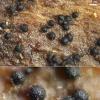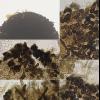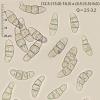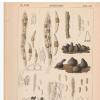
30-11-2025 12:53
 Edvin Johannesen
Edvin Johannesen
White short-stipitate apothecia found on thin twig

30-11-2025 10:47
 William Slosse
William Slosse
I recently found a collection of small Peziza sp.

27-11-2025 12:01
Thomas Læssøehttps://svampe.databasen.org/observations/10496727

27-11-2025 11:46
Thomas Læssøehttps://svampe.databasen.org/observations/10493918

17-09-2025 10:50
Heather MerryleesHi there!I am hoping for any advice on the identif

29-11-2025 08:40
 Andreas Millinger
Andreas Millinger
Hello,on a splintered part of a branch on the grou

28-11-2025 16:45
Nogueira HéctorNovember 23, 2025 Requejo de Sanabria (León) SPAI

25-11-2025 14:24
Thomas Læssøehttps://svampe.databasen.org/observations/10490522

27-11-2025 15:41
Thomas LæssøeSpores brownish, typically 4-celled; 26.8 x 2.4;

27-11-2025 11:31
Thomas LæssøeCollectors notes: Immersed ascomata, erumpent thro
Capronia
Enrique Rubio,
28-07-2025 12:34
I would appreciate any ideas about this small Capronia with small pseudothecia measuring 250-300 microns in diameter, with walls that are barely rough due to the presence of dark, poorly developed protruding cells. Developed hairs are barely present or are very few in number.
The ascospores are always tri-septate, olive-coloured and generate conidia at maturity and after their expulsion from the asci.
These ascomata grew in small groups on Fagus sylvatica wood in the vicinity of Claussenomyces prasinulus apothecia, but not on them. No other fungi have been seen in the vicinity.
Many thanks in advance for your help.
Enrique Rubio,
28-07-2025 13:08
Gernot Friebes,
28-07-2025 17:10
Re : Capronia
Hi, Enrique!
Purely based on morphology and ecology, I think that your collection belongs in the vicinity of C. pilosella. There are various authors who report very similar ascospore measurements, and the development of the setae is known to vary. See, for example, this quote by Untereiner (1997): "ascomata occasionally bearing only dark, protruding cells or entirely lacking setae."
Best wishes,
Gernot
Purely based on morphology and ecology, I think that your collection belongs in the vicinity of C. pilosella. There are various authors who report very similar ascospore measurements, and the development of the setae is known to vary. See, for example, this quote by Untereiner (1997): "ascomata occasionally bearing only dark, protruding cells or entirely lacking setae."
Best wishes,
Gernot
Enrique Rubio,
29-07-2025 18:36
Re : Capronia
Dear Gernot
I believe that spores of pilosella spores are quite different, generally wider, with a higher Q and less curved. But this may just be my personal opinion.Thank you very much for your help.
It is a difficult genus!
I believe that spores of pilosella spores are quite different, generally wider, with a higher Q and less curved. But this may just be my personal opinion.Thank you very much for your help.
It is a difficult genus!
Gernot Friebes,
29-07-2025 19:25
Re : Capronia
Yes, definitely in need of a proper revision...
Best wishes,
Gernot
Best wishes,
Gernot
Enrique Rubio,
29-07-2025 19:30
Re : Capronia
Best wishes, Gernot.




